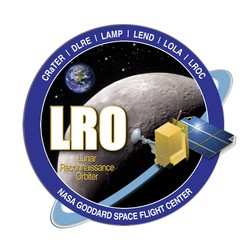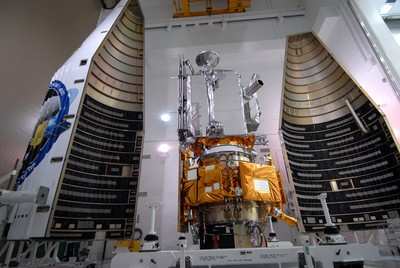Wed, Jun 24, 2009
Mapping The Moon In Advance Of Man's Return
 After a four and a
half day journey from the Earth, the Lunar Reconnaissance Orbiter,
or LRO, has successfully entered orbit around the moon. Engineers
at NASA's Goddard Space Flight Center in Greenbelt, MD, confirmed
the spacecraft's lunar orbit insertion at 0627 EDT Tuesday.
After a four and a
half day journey from the Earth, the Lunar Reconnaissance Orbiter,
or LRO, has successfully entered orbit around the moon. Engineers
at NASA's Goddard Space Flight Center in Greenbelt, MD, confirmed
the spacecraft's lunar orbit insertion at 0627 EDT Tuesday.
During transit to the moon, engineers performed a mid-course
correction to get the spacecraft in the proper position to reach
its lunar destination. Since the moon is always moving, the
spacecraft shot for a target point ahead of the moon. When close to
the moon, LRO used its rocket motor to slow down until the gravity
of the moon caught the spacecraft in lunar orbit.
"Lunar orbit insertion is a crucial milestone for the mission,"
said Cathy Peddie, LRO deputy project manager at Goddard. "The LRO
mission cannot begin until the moon captures us. Once we enter the
moon's orbit, we can begin to buildup the dataset needed to
understand in greater detail the lunar topography, features and
resources. We are so proud to be a part of this exciting mission
and NASA's planned return to the moon."
A series of four engine burns over the next four days will put
the satellite into its commissioning phase orbit. During the
commissioning phase each of its seven instruments is checked out
and brought online. The commissioning phase will end approximately
60 days after launch, when LRO will use its engines to transition
to its primary mission orbit.

For its primary mission, LRO will orbit above the moon at about
31 miles, or 50 kilometers, for one year. The spacecraft's
instruments will help scientists compile high resolution,
three-dimensional maps of the lunar surface and also survey it at
many spectral wavelengths.
The satellite will explore the moon's deepest craters, examining
permanently sunlit and shadowed regions, and provide understanding
of the effects of lunar radiation on humans. LRO will return more
data about the moon than any previous mission.
More News
From 2023 (YouTube Version): Legacy of a Titan Robert (Bob) Anderson Hoover was a fighter pilot, test pilot, flight instructor, and air show superstar. More so, Bob Hoover was an i>[...]
Get The Latest in Aviation News NOW on Instagram Are you on Instagram yet? It's been around for a few years, quietly picking up traction mostly thanks to everybody's new obsession >[...]
Aero Linx: B-52H Stratofortress The B-52H Stratofortress is a long-range, heavy bomber that can perform a variety of missions. The bomber is capable of flying at high subsonic spee>[...]
Altimeter Setting The barometric pressure reading used to adjust a pressure altimeter for variations in existing atmospheric pressure or to the standard altimeter setting (29.92).>[...]
"Knowing that we play an active part in bettering people's lives is extremely rewarding. My team and I are very thankful for the opportunity to be here and to help in any way we ca>[...]
 Classic Aero-TV: Remembering Bob Hoover
Classic Aero-TV: Remembering Bob Hoover ANN FAQ: Follow Us On Instagram!
ANN FAQ: Follow Us On Instagram! ANN's Daily Aero-Linx (05.15.24)
ANN's Daily Aero-Linx (05.15.24) ANN's Daily Aero-Term (05.15.24):Altimeter Setting
ANN's Daily Aero-Term (05.15.24):Altimeter Setting Aero-News: Quote of the Day (05.16.24)
Aero-News: Quote of the Day (05.16.24)




